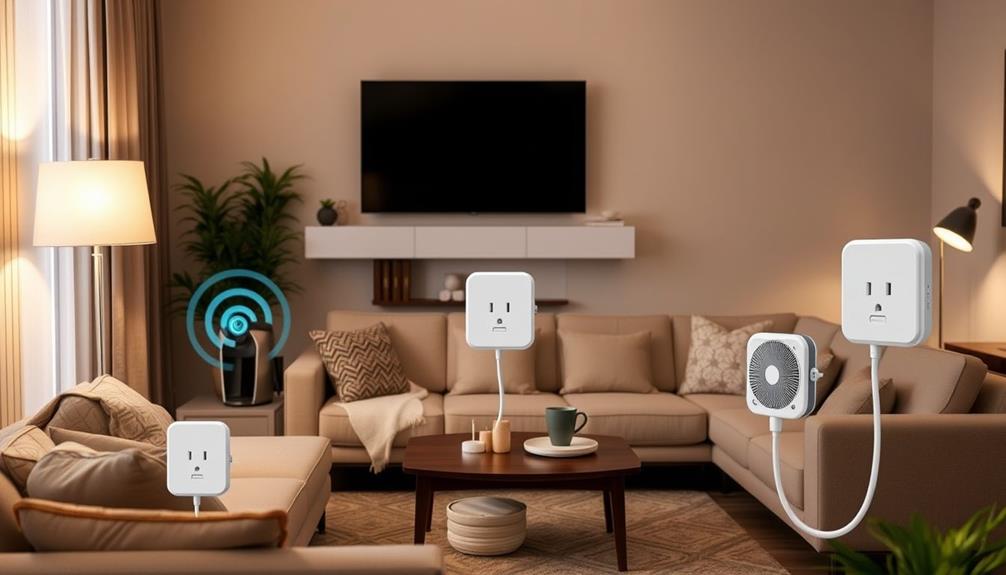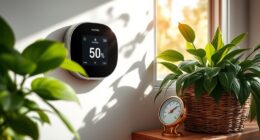Smart plugs allow you to easily transform any appliance into a smart device. With options such as the TP-Link Kasa Smart Wi-Fi Plug Slim for indoor use and the weather-resistant TP-Link Tapo TP25 for outdoor gadgets, you are covered for any environment. Look for plugs that provide energy monitoring to help manage your electricity costs, compatibility with major voice assistants for hands-free control, and compact designs to make the most of your outlet space. Don’t overlook the multi-plug options for larger setups! To discover the best choices available, continue exploring your options to find the ideal smart plug for your requirements.
Key Takeaways
- Smart plugs convert standard appliances into smart devices, offering remote control via apps and voice commands.
- Look for energy monitoring features to track electricity usage and reduce bills effectively.
- Ensure compatibility with major smart home platforms like Amazon Alexa and Google Assistant for seamless integration.
- Consider weather resistance ratings, such as IP65, for outdoor smart plug applications.
- Choose compact designs to maximize outlet accessibility without blocking adjacent sockets.
Overview of Smart Plugs
Smart plugs are innovative devices that turn your everyday appliances into smart technology, giving you the power to control them from anywhere. By simply plugging these devices into a standard outlet, you can transform any appliance into a smart device that responds to your commands.
You'll love the convenience of managing your devices remotely through smartphone apps or using voice control with systems like Amazon Alexa, Google Assistant, or Apple HomeKit. In addition, effective keyword clustering can enhance your understanding of which smart plugs to choose based on their features and user ratings.
One of the standout features of smart plugs is their energy monitoring capability. You can track your electricity usage in real time, helping you identify which appliances consume the most energy. This insight allows you to make informed decisions and ultimately save on your energy bills.
Additionally, smart plugs typically come with scheduling and timer functionalities. This means you can automate the operation of your devices at specified times, ensuring they run only when you need them.
Most designs fit snugly into standard outlets without blocking adjacent sockets, making them practical for everyday use. With smart plugs, you're not just upgrading your appliances; you're enhancing your entire home's efficiency and convenience.
Key Features to Consider
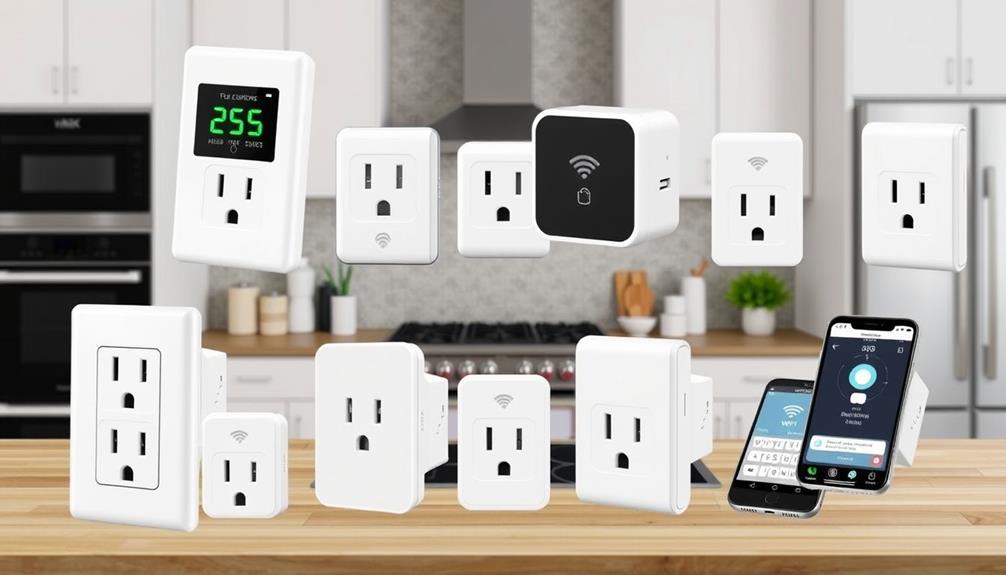
When choosing a smart plug, it's essential to focus on key features that will enhance your experience and meet your needs.
First off, consider energy monitoring capabilities. This feature allows you to track electricity usage, helping you save on bills and make informed decisions about your energy consumption. Models like the TP-Link Kasa Smart Wi-Fi Plug Slim provide detailed reports that can be incredibly useful, as seen in advancements in AI applications in various industries that optimize energy use.
Next, verify compatibility with major smart home platforms like Amazon Alexa, Google Assistant, and Apple HomeKit. This compatibility enables seamless integration with your existing devices, creating a cohesive smart home ecosystem.
If you're planning to use your smart plug outdoors, check for weather resistance ratings. Look for plugs with ratings like IP65, which will guarantee they can withstand various environmental conditions without compromising functionality.
Lastly, don't overlook compact designs that won't obstruct adjacent outlets, allowing better utilization of multi-outlet setups.
With these key features in mind, you're well on your way to selecting a smart plug that fits your lifestyle and elevates your home automation experience.
Best Indoor Smart Plug

If you're looking to upgrade your indoor devices, the TP-Link Kasa Smart Wi-Fi Plug Slim (EP25) is a top choice. This is widely regarded as the best indoor smart plug for a reason.
It's designed for reliability and offers real-time energy monitoring, allowing you to track how much energy your devices are using, which can help reduce your electric bill. Incorporating smart technology into your home can also enhance air quality, especially when paired with devices like ozone air purifiers, which effectively eliminate allergens and odors.
Compatible with major smart home platforms like Amazon Alexa, Google Home, Apple Home, and Samsung SmartThings, it integrates seamlessly into your existing smart setup. Priced at around $35 for a pack of four, it provides excellent value for transforming multiple devices into smart gadgets.
One of the standout features is the Away Mode, which simulates occupancy by randomly turning devices on and off, enhancing your home's security. Plus, the user-friendly app controls make scheduling and routines a breeze.
The compact design guarantees it won't block adjacent outlets, making it perfect for tight spaces. With the TP-Link Kasa Smart Wi-Fi Plug Slim, you can effortlessly make your home smarter and more efficient.
Best Outdoor Smart Plug

Best Outdoor Smart Plug
When it comes to outdoor smart plugs, the TP-Link Tapo TP25 stands out with its IP65 weather resistance, ensuring it can handle the elements.
This product is designed for versatility and durability, making it ideal for outdoor use. You'll appreciate its dual outlet control, letting you manage multiple devices at once, and its energy monitoring features help you keep track of usage.
With this plug, automating your outdoor appliances becomes both easy and efficient, especially if you're looking to enhance your home cleaning routines with professional cleaning services.
Weather Resistance Features
Weather resistance is essential for outdoor smart plugs, ensuring they remain functional despite the elements. The TP-Link Tapo TP25 Outdoor Plug is a prime example, boasting an IP65 weather resistance rating. This means it can confidently withstand rain and dust, making it ideal for your outdoor needs.
Additionally, similar to how wood pellet fireplaces operate efficiently in challenging environments, this smart plug provides reliable performance regardless of weather conditions.
With this smart plug, you can enjoy remote management capabilities, allowing you to control your devices from anywhere using a smartphone app. Whether you're automating garden lights or fountains, you'll appreciate how this plug tracks device running time, giving you insights into energy consumption. It's not just about convenience; it's also about being energy-efficient.
At just $20 on Amazon, it's an affordable investment for enhancing your outdoor experience. Plus, compatibility with major smart home platforms like Amazon Alexa and Google Assistant means you can easily manage your devices through voice commands.
You'll find that this combination of weather resistance and smart technology makes the TP-Link Tapo TP25 one of the best options for outdoor smart plugs on the market. Embrace the convenience and reliability of smart plugs that can handle the outdoors without compromising functionality.
Dual Outlet Control
Flexibility is a key advantage of the TP-Link Tapo TP25 Outdoor Plug, thanks to its independently controllable dual outlets. This feature allows you to manage two outdoor devices separately, so you can customize your outdoor setup without hassle.
Whether you're looking to control your garden lights and fountain or holiday decorations, the dual outlet control makes it easy and convenient. This setup not only enhances your outdoor experience but also aligns with the principles of design thinking, emphasizing user-centered solutions that cater to individual needs.
The Tapo TP25 isn't just versatile; it's built for outdoor use too. With an IP65 weather resistance rating, it performs reliably in various conditions, from rain to dust. You won't have to worry about sudden weather changes affecting your devices.
Moreover, the TP-Link Tapo TP25 is compatible with major smart home platforms, which means you can integrate it seamlessly into your existing setup. With voice control through Amazon Alexa or Google Assistant, you can manage your outdoor devices hands-free. Just say the word, and you're in control.
At around $20 on Amazon, the Tapo TP25 is an affordable solution for automating your outdoor devices. Elevate your outdoor experience with this smart plug and enjoy the convenience it brings to your home.
Energy Monitoring Capabilities
The TP-Link Tapo TP25 Outdoor Smart Plug goes beyond just controlling your devices with its impressive energy monitoring capabilities.
Utilizing smart technology to optimize energy usage is becoming increasingly important as more households look to adopt sustainable practices, such as those seen in geothermal energy applications.
You can easily track device runtime and energy consumption in kilowatt-hours (kWh) through the intuitive Tapo app. This feature helps you gain insights into your power usage patterns and identify energy-heavy devices.
Here are three key benefits of the Tapo's energy monitoring capabilities:
- Cost Savings: By monitoring energy consumption, you can make informed decisions to reduce electricity costs by adjusting usage habits.
- Real-Time Insights: The Tapo app provides real-time data and historical usage statistics, allowing you to optimize energy consumption for outdoor appliances like string lights and garden tools.
- Independent Control: With independently controllable dual outlets, you can manage multiple outdoor devices and monitor their energy usage separately, enhancing overall efficiency.
Best Multi-Plug Power Strip

Finding the best multi-plug power strip can significantly enhance your smart home experience. The TP-Link Kasa Smart Wi-Fi Power Strip (HS300) stands out as an excellent choice. This smart power strip converts one outlet into six independently controlled outlets, allowing you to manage multiple devices effortlessly. Plus, it features built-in energy monitoring, so you can track energy consumption for each outlet and optimize your usage.
You'll also appreciate the compatibility with major smart home platforms like Amazon Alexa and Google Assistant, enabling seamless voice control for all your connected devices. Additionally, it includes three USB ports, providing extra charging options for smartphones and tablets without hogging additional outlets.
Here's a quick comparison of the TP-Link Kasa Smart Wi-Fi Power Strip with other options:
| Feature | TP-Link Kasa HS300 | Competitor A | Competitor B |
|---|---|---|---|
| Smart Control | Yes | Yes | No |
| Energy Monitoring | Yes | No | Yes |
| Voice Control | Alexa & Google | Alexa |
Priced at approximately $43, this power strip combines functionality and convenience, making it a valuable addition to any smart home setup.
Best Compact Smart Plug
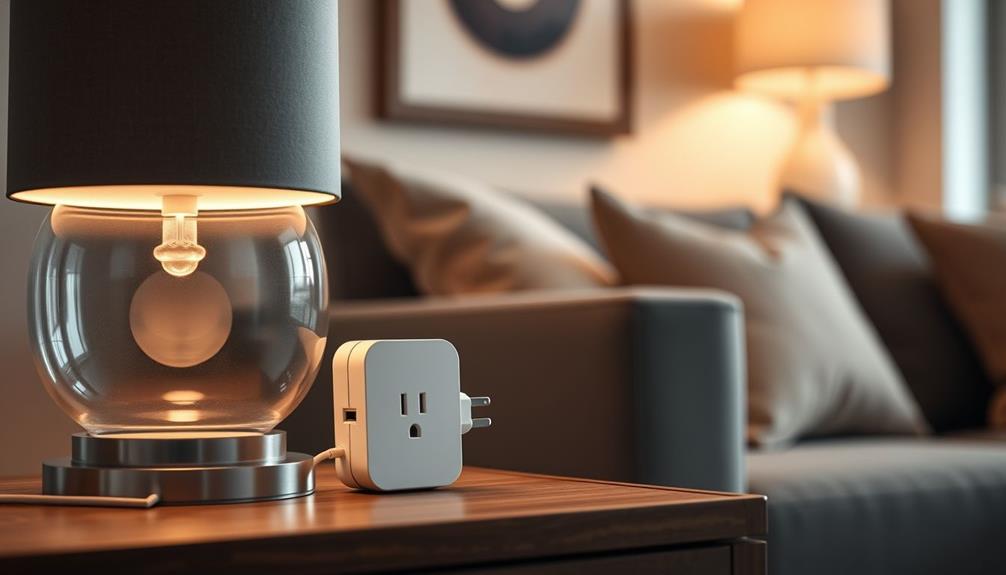
When you're tight on space, a compact smart plug can be a game changer.
These devices not only optimize your outlets but also enhance your home environment, similar to how understanding feline behavior and emotional connection can improve your relationship with your pets.
The TP-Link Kasa Smart Wi-Fi Plug Mini and Meross Wi-Fi Smart Plug Mini not only save room but also offer compatibility with popular voice assistants and smart home systems.
With these plugs, you can easily control your devices without worrying about cluttering your outlets.
Space-Saving Design Benefits
Compact smart plugs, like the TP-Link Kasa Smart Wi-Fi Plug Mini (EP10), offer significant space-saving benefits, making them perfect for tight areas.
Their compact design allows you to plug them into standard outlets without blocking adjacent sockets, which is a game-changer in crowded spaces. They're particularly useful for managing multiple devices, just like how well-draining soil is essential for healthy plant growth.
Here are three key benefits of using these compact smart plugs:
- Minimal Footprint: Their small size guarantees they fit snugly in any outlet, allowing multiple devices to be plugged in without interference.
- Affordable Integration: Many options are budget-friendly, with prices around $10, enabling you to enhance your smart home without breaking the bank.
- Smart Features: Despite their size, compact smart plugs come packed with essential functionalities such as scheduling, timers, and energy monitoring, often compatible with major voice assistants like Amazon Alexa and Google Assistant.
Versatile Compatibility Options
The TP-Link Kasa Smart Wi-Fi Plug Mini (EP10) stands out for its impressive versatility, seamlessly integrating with major smart home platforms like Amazon Alexa, Google Assistant, and Samsung SmartThings. This compatibility makes it a fantastic choice for anyone looking to enhance their home automation setup without hassle.
Additionally, considering the importance of protecting investments, it's wise to research reputable products just like you'd when exploring Gold IRA providers for legitimacy and reliability. You can control your devices using voice commands through Alexa or Google Assistant, providing convenience at your fingertips.
Measuring just 2.36 x 2.03 x 1.5 inches, the compact design lets you plug it in without blocking other outlets. The Kasa app simplifies device management, making it accessible even if you're new to smart technology.
You'll appreciate the scheduling and timer features that let you automate your appliances effortlessly. Plus, the Away Mode adds an extra layer of security by mimicking your presence at home, turning devices on and off randomly.
At around $10, the Kasa Smart Plug Mini offers excellent value for those wanting to engage in smart home automation without breaking the bank. With its versatile compatibility options, you'll find it easy to create a connected and efficient living space.
Runner-Up Options
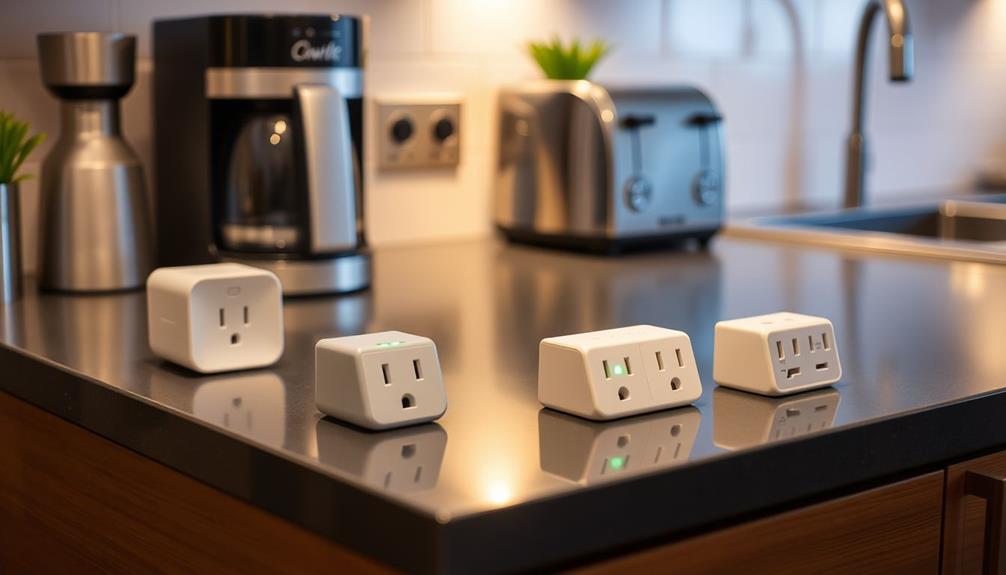
For those seeking alternatives in the smart plug market, several runner-up options stand out. These smart plugs offer a range of features and prices, making them great choices for various needs.
- TP-Link Kasa Smart Wi-Fi Plug Mini (EP10): At around $10, this smart plug Mini boasts a compact design that won't block your other outlets. It also includes programmable scenes and an away mode for added convenience.
- Wyze Plug: Priced at $17 for a two-pack, this affordable smart plug supports Google Assistant and Alexa. It features vacation mode and daily/weekly runtime monitoring, perfect for managing your devices when you're away.
- Meross Wi-Fi Smart Plug Mini: Tailored for Apple HomeKit users, this plug is compatible with Google Assistant and Alexa. You can grab a single plug for approximately $53 or a pack of four for around $40, making it a versatile option.
Whether you need a smart plug Mini for compact spaces or an affordable smart option for budget-conscious buyers, these runner-up choices are worth considering.
Privacy and Security Considerations

When considering smart plugs, it's important to address privacy and security concerns that come with these devices. Many smart plugs, like those from TP-Link, collect personal information such as your name, email, and phone number during usage and support. They also utilize cookies to gather data like your IP address. This raises questions about how your data is handled.
To enhance security, user data is encrypted in the cloud, and TP-Link offers two-factor authentication for its Tapo app users, though it's not mandatory.
It's essential for you to review the privacy settings and data collection practices of the smart plug manufacturers you choose. Some plugs may share your data with third-party services to improve functionality, which can lead to potential privacy concerns.
Understanding the privacy policies provided within the Tapo app can help you better grasp your user rights and how your information is protected. Transparency is key, so don't hesitate to dig into these details before making a purchase.
Limitations of Smart Plugs

Steering through the limitations of smart plugs can be essential for maximizing your smart home experience. While these devices offer convenience, they also come with some drawbacks you should consider.
- Lack of Surge Protection: Many smart plugs don't include surge protection, leaving your connected devices vulnerable to power surges, which can cause damage.
- Limited Compatibility: Some models, like the TP-Link Kasa Smart Wi-Fi Power Strip (HS300), don't support Apple Home, which may restrict your ability to integrate them into your existing smart home ecosystem.
- Energy Monitoring Absence: Certain plugs, including the TP-Link Kasa Smart Wi-Fi Plug Mini (EP10), lack energy monitoring features. This limits your ability to track energy consumption effectively, making it harder to manage your electricity usage.
Additionally, you might face connectivity issues if your Wi-Fi network doesn't support the necessary 2.4 GHz band, as many smart plugs aren't compatible with the faster 5 GHz band.
How We Tested Smart Plugs

When testing smart plugs, you'll want to focus on specific evaluation criteria that reflect real-life usage scenarios.
We looked at how easy it's to set up each plug and how well they integrate with your smart home devices.
Evaluation Criteria for Testing
Testing smart plugs involves a detailed evaluation process that focuses on several key criteria to confirm they meet user needs effectively. To guarantee you get the best performance, we examined the following aspects:
- Ease of installation and setup: We assessed how quickly and intuitively users could set up the smart plugs, including compatibility with iOS and Android apps.
- Energy monitoring accuracy: This involved testing the plugs to see how accurately they tracked energy usage, providing you with reliable data to manage your consumption.
- Voice command integration: We analyzed how well the plugs worked with popular voice assistants like Amazon Alexa and Google Assistant, ensuring seamless operation through voice commands.
Additionally, we evaluated the physical design to prevent blockage of adjacent sockets and gathered user experience feedback to assess long-term performance and customer support responsiveness.
Real-Life Usage Scenarios
To truly understand how smart plugs perform in everyday life, we conducted hands-on tests in various real-life usage scenarios. Over a week, we automated lamps to evaluate the ease of scheduling and remote control functionality. You'd appreciate how straightforward it's to set timers or turn lights on and off using your smartphone or voice commands.
We also tested compatibility with major voice assistants like Amazon Alexa and Google Assistant. You can easily control your devices by simply saying, "Turn on the living room lamp," making daily routines more convenient.
Energy monitoring capabilities were another key focus. We tracked the power consumption of devices plugged into smart plugs, giving you insights into their efficiency and helping you save on energy bills.
Setup procedures were evaluated for user-friendliness, ensuring seamless app integration and Wi-Fi connection processes. We noted any factory resets needed for updates, which can be annoying.
Lastly, we checked the practicality of each smart plug, confirming they wouldn't block adjacent outlets when installed.
Frequently Asked Questions
Do Smart Plugs Work With Any Appliance?
Smart plugs don't work with every appliance. They're great for devices with standard power switches, but avoid those needing continuous power or built-in smart technology. Always check compatibility with your home Wi-Fi network too.
What Is the Best Smart Plug in the Market?
When you're looking for the best smart plug, consider the TP-Link Kasa Smart Wi-Fi Plug Slim. It combines affordability, energy monitoring, and compatibility with major smart home platforms, making it a top choice for many users.
What Is the Difference Between a Smart Plug and a Smart Socket?
Did you know that over 30% of households use smart plugs? A smart plug offers portability and affordability, while a smart socket provides advanced features and requires installation, making them distinct in smart home setups.
How to Choose a Smart Plug?
When choosing a smart plug, consider compatibility with your smart home system, essential features like energy monitoring and scheduling, size for outlet fit, and pricing options. Compare models to find what best suits your needs.
Conclusion
In a world where convenience reigns, smart plugs are your trusty sidekicks, turning ordinary appliances into tech-savvy helpers. Whether you're looking to control your coffee maker or outdoor lights, there's a perfect plug for you. With the right features and a bit of caution regarding privacy, you can easily elevate your home's intelligence. So, don't just plug in—plug into a smarter lifestyle and watch your home transform, one device at a time!
